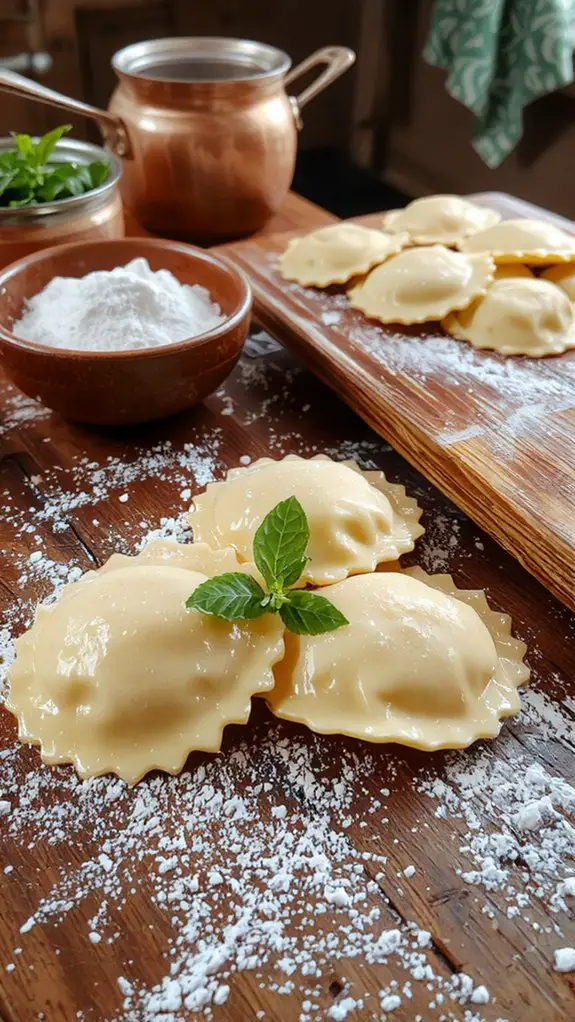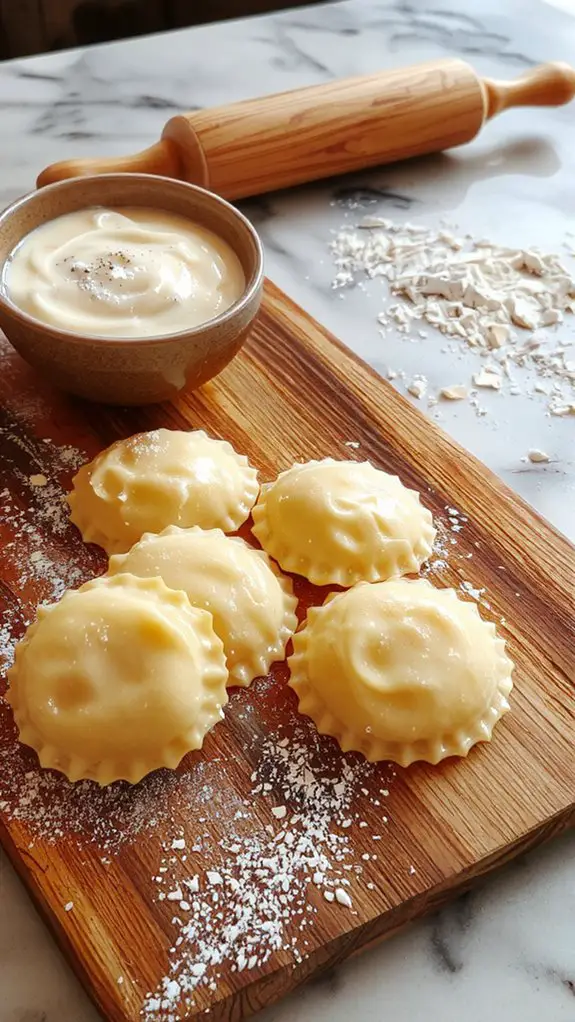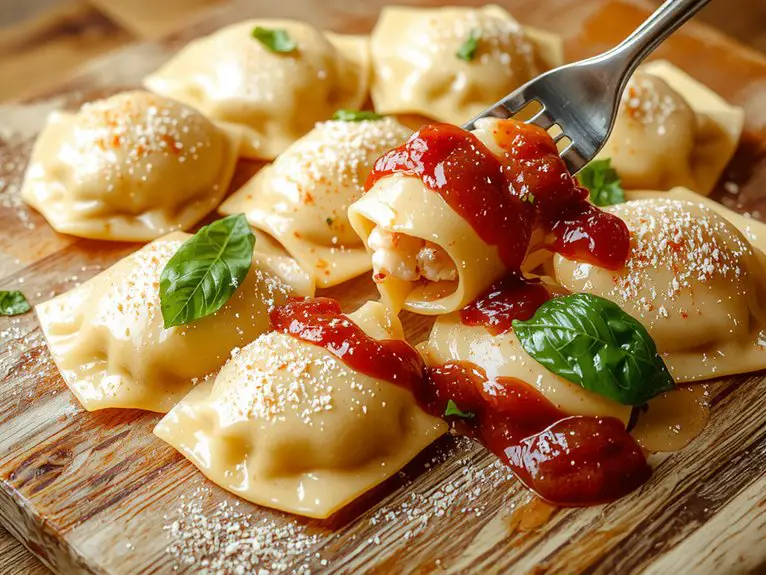I’ve spent years perfecting my homemade ravioli recipe, and I’m convinced it’s the best version out there. The key lies in the delicate balance of a silky dough and a rich, creamy filling that melts in your mouth. But there’s one step most people overlook that makes all the difference. If you’ve ever wondered how to elevate your ravioli from good to unforgettable, this might just change the way you make them forever.
Recipe
There’s something downright magical about homemade ravioli—once you taste it, the store-bought stuff just won’t cut it anymore. This recipe is my go-to for a reason: silky, tender pasta pockets stuffed with a rich, creamy filling that melts in your mouth.
The secret? A simple but foolproof dough made with just flour and eggs, rolled thin enough to let the filling shine. I’ve made these for countless dinners, and every time, they disappear faster than I can plate them.
Whether you’re a pasta newbie or a seasoned cook, this recipe is your ticket to restaurant-quality ravioli at home—no fancy equipment needed, just a little patience and a lot of love. Trust me, one bite of these pillowy pockets, and you’ll never look back.
Ingredients
Making homemade ravioli is all about quality ingredients—each one plays a vital role in creating tender pasta and a flavorful filling. Here’s what you’ll need, along with some chef-approved swaps and secrets:
For the Pasta Dough:
- 00 flour – The gold standard for silky, elastic dough (all-purpose flour works in a pinch, but the texture won’t be as delicate).
- Eggs – Use large, room-temperature eggs for better dough consistency.
- Olive oil – A splash adds richness and prevents sticking.
- Salt – Just a pinch to enhance the pasta’s flavor.
For the Filling:
- Whole-milk ricotta – Avoid skim—the extra fat makes the filling creamy and luscious.
- Parmigiano-Reggiano – Freshly grated is non-negotiable for its nutty depth (pre-shredded won’t melt the same).
Filling Continued:
- Egg yolk – Binds the filling without making it watery.
- Nutmeg – A tiny pinch elevates the cheese with warmth (trust us, it’s magic).
- Fresh herbs – Basil or parsley add brightness; dried herbs taste dusty here.
Extras for Serving:
- Brown butter – Takes 5 minutes but transforms the dish with toasty richness.
- Fresh sage leaves – Crisped in the butter for an aromatic crunch.
- Lemon zest – A sprinkle at the end cuts through the richness.
Pro Tip: If you’re short on time, wonton wrappers can stand in for fresh pasta—just boil them gently to avoid tearing. But for the real deal, homemade dough is worth the effort!
How to Make the Best Traditional Cheese Ravioli Recipe

– Prepare the dough: Start by making the pasta dough—combine flour and eggs in a large bowl, mixing until a shaggy dough forms. Knead on a floured surface for about 10 minutes until smooth and elastic.
Wrap in plastic and let it rest for 30 minutes at room temperature. Resting allows the gluten to relax, making the dough easier to roll.
– Make the filling: While the dough rests, prepare the cheese filling. Mix ricotta, Parmesan, mozzarella, egg, salt, pepper, and nutmeg in a bowl until well combined. Taste and adjust seasoning if needed.
Cover and refrigerate to firm up the mixture, making it easier to handle.
– Roll out the dough: After resting, divide the dough into 4 equal pieces. Use a pasta roller or rolling pin to roll each piece into thin sheets (about 1/16-inch thick). If using a roller, start at the widest setting and gradually decrease until the dough is translucent.
Keep the sheets lightly floured to prevent sticking.
– Assemble the ravioli: Lay one sheet of dough on a floured surface. Place teaspoon-sized dollops of filling about 2 inches apart. Brush water around each filling mound to help seal.
Carefully lay a second sheet of dough over the top, pressing gently around the filling to remove air pockets. Use a ravioli cutter or sharp knife to cut into individual ravioli, pressing the edges firmly to seal.
– Cook the ravioli: Bring a large pot of salted water to a gentle boil (not a rolling boil). Add the ravioli in batches, stirring gently to prevent sticking.
Cook for 3-4 minutes or until they float to the surface. Avoid overcooking, as the pasta will become mushy.
– Serve immediately: Remove the ravioli using a slotted spoon and transfer to a serving dish. Toss with your favorite sauce (e.g., marinara, browned butter, or pesto) and garnish with grated Parmesan or fresh herbs.
Serve warm for the best texture and flavor.
Pro Tips:
- Avoid overfilling: Too much filling can cause the ravioli to burst during cooking. Stick to teaspoon-sized portions.
- Seal tightly: Make sure edges are well-sealed to prevent filling from leaking out.
- Freeze extras: Uncooked ravioli can be frozen on a baking sheet, then transferred to a freezer bag for up to 3 months. Cook directly from frozen, adding a minute or two to the cooking time.
Nutrition
This homemade ravioli recipe is both delicious and nutritious. Here’s the nutritional breakdown per serving.
| Nutrient | Amount per Serving |
|---|---|
| Calories | 320 kcal |
| Protein | 14g |
| Carbohydrates | 42g |
| Fat | 10g |
| Fiber | 3g |
| Sodium | 480mg |
Chef Tips
When you’re rolling out the pasta dough for homemade ravioli, I recommend keeping it slightly thicker than you’d think—it helps prevent tearing when filling and sealing.
Use a piping bag for neat filling placement, and press out air bubbles before sealing to avoid bursting.
Dust your work surface lightly with flour, but don’t overdo it.
Fresh herbs in the filling elevate flavor, so don’t skip them.






